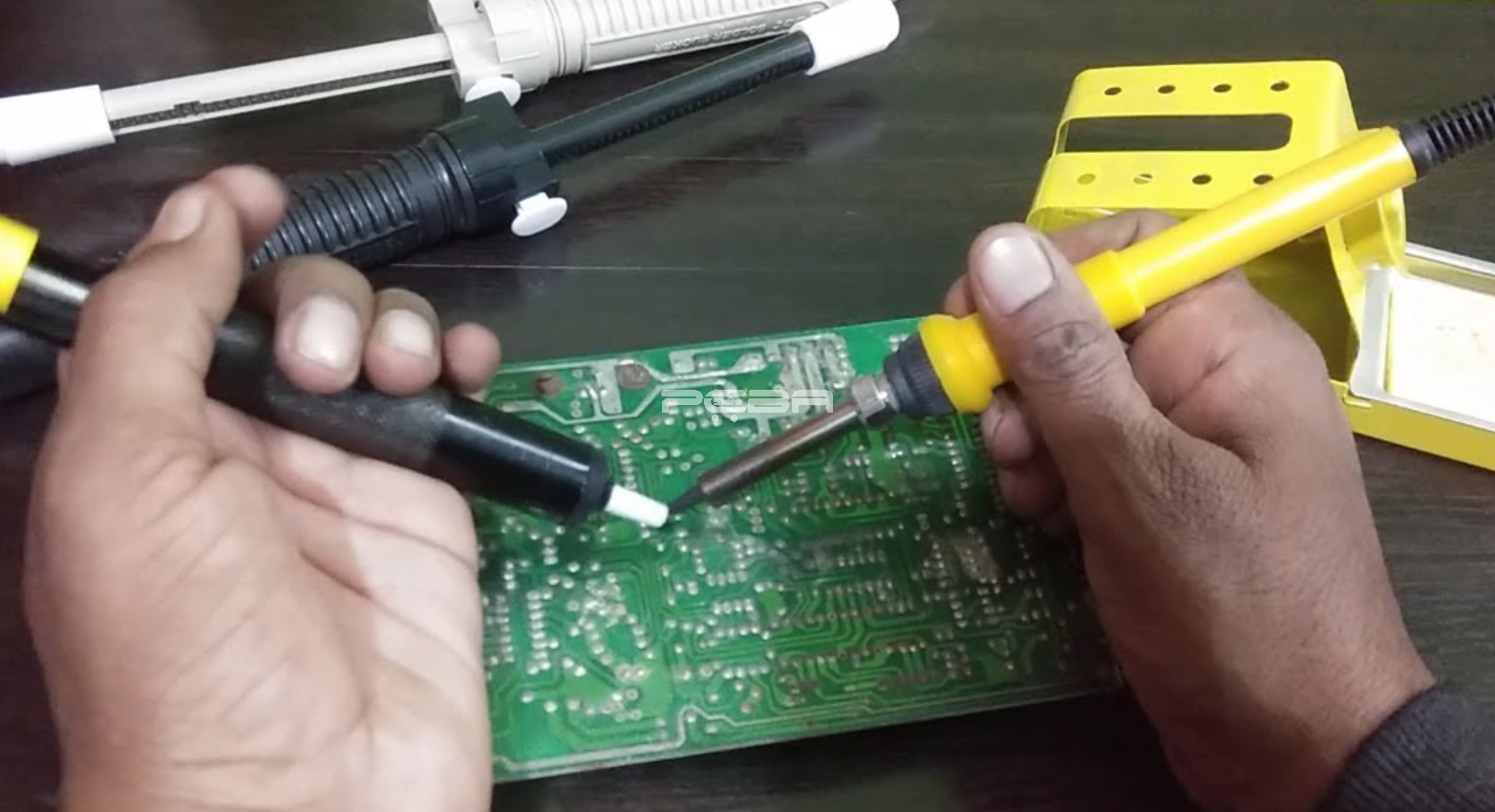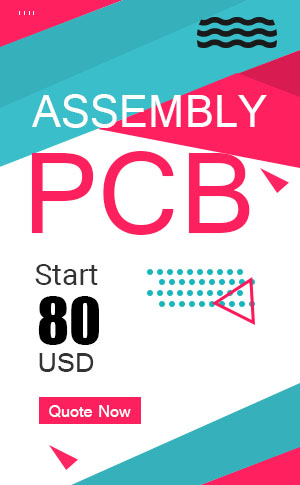General, quoting & support.
Add: Building E, No.58, Nanchang Road, Xixiang , Baoan District Shenzhen City, Guangdong, China
Tel : 0755-27348887
Fax : 0755-27349876
E-mail : svc@pcbastore.com
How to Use Desoldering Pump
Simon / 2021-03-21
Contents [hide]
So, you may have heard about a desoldering pump or had an idea that basically reflects such a piece of equipment, but do you know what that little device was made for? Well, we are going to cover that today. If you already have one, perhaps you'll want to know how to use a desoldering pump- let's ride to the end.

What is a desoldering pump?
A desoldering pump is just but a handheld soldering gun-like tool used for desoldering existing connections on a PCB. It is also known as a desolder pump.
The process of desoldering a printed circuit board aims at repairing or modifying the existing connections, interchanging connections, or even extracting a given component to be used elsewhere. Given the intricacy with which these components and connections must be handled, a solder pump offers the perfect solution.
Advantages of using a desoldering pump
As mentioned above, a desoldering pump is a small hand tool used to melt away and remove solder on existing board connections. This tool's size allows easier removal of solder even from the tiny joints that may be microscopic sometimes. To cater for extra small joints or tightly packed surfaces, smaller, more adaptable desoldering guns are available. Below are some more advantages of using a desolder pump:
A desoldering pump makes the processes of troubleshooting and repairing components easier. This is because the problem can be narrowed down to a single element which can then be replaced or repaired as need dictates.
Some desolder pumps come with built-in heat guns. This eliminates any need to use a second hand tool for melting the solder. Ultimately, this makes the work easier for the person desoldering as they will not have to keep in mind what sections they have heated. The pump sucks in the solder as it liquefies the latter. There are reduced errors too from working with such a desolder pump.
Most desolder guns are made to work at a microscopic scale. When working on a board, the user will not strain his/her eyes like it would be the case with other similar handheld tools. With lesser strain, you can expect to achieve more repair work within shorter periods.
When you use a desoldering pump, you can intricately and conveniently remove the solder without damaging the entire PCB board. You can then re-print the board to accommodate a different connection or process. Some board components are quite expensive and can be easily damaged. Such can best be extracted with a desoldering pump, increasing the sustainability of in-house PCB designing and production.
A desoldering pump allows for the careful extraction of components from a PCB. In other words, short, components desoldered this way can be recycled as they are usually ever damaged in the process. Apart from cutting the costs of acquiring new components, the process reduces waste and thus pollution.
Disadvantages of using a desoldering pump
Notably, there are two types of desoldering pumps; bulb and syringe designs. The bulb type, just like the name tells it all, is sometimes too large for microscopic tasks. Although both types are designed to handle the tiniest desoldering tasks, the bulb type is still large for some spaces.
How to use a desoldering pump
We have so far discussed the basics regarding the solder sucker. It's now time to understand how exactly this tool should be used. The following procedure will have you started and using your new desoldering pump within no time:
From your electric desoldering pump, apply some heat to the board. If your solder sucker doesn't have a soldering rod, you will need to do this part manually. You should, however, upgrade to one with a soldering rod so you can do both soldering and desoldering with the single tool.
For the plunger or syringe-type solder sucker, the user presses the plunger lightly to apply pressure. On the other hand, the bulb-type desoldering pump requires the user to squash the molten solder with the bulb tip.
After the solid solder has liquefied under heat, the pump or sucker is then placed at the liquefied points to start the sucking.
After the proper placement of the pump, the user then releases the plunger. Different pumps may have slightly different working mechanisms. Thus, you may find some models have a release button that you press just once, and the pump starts actuating (sucking).
After the plunger is released, the pump slowly sucks in the molten solder. If one cycle is not enough, it may be necessary to perform several sucking cycles. Once the process is complete, the user should then work on cleaning the pump.
Although we shall cover the cleaning procedure in a short while, it basically involves pressing down the plunger of the desoldering pump to purge out the sucked solder.
When sucking the solder, it is hard to suck the right amount from the molten pool. To cover for any solder removed in excess, just add a little solder back to the joint.
Using a desoldering pump is as easy as that!
Essential procedures for desoldering a circuit board
Desoldering usually involves two key processes. Understanding these processes is key to grasping all the procedures involved in desoldering. One method utilizes a desoldering pump, just as explained above, while the second method employs a blast of hot air combined with a vacuum pump. In the latter method, the hot air blast is used to melt the solder away. The molten solder is then sucked by a vacuum pump, or if the bits are large enough, a pair of tweezers can also be used to collect the bits.
So, what are the essential procedures for desoldering, regardless of the method used? We learn that next- just hang in.
1) Choose a good soldering rod
If you are using a desolder pump that has inbuilt ironing heads, you may not need to select the soldering iron- it's already installed. The only thing you can do here is to ensure you buy a pump that has good soldering iron.
If you have to use a soldering iron separately, you must go for a high-quality one that has a temperature display. Ensure the cable is also flexible to accommodate movements, and finally, check if the tip is clear and clean. This way, the iron will remain conductive throughout the process.
High-quality soldering irons will cost more and last longer. It's certainly the way to go.
2) Get a suitable holder for the PCB
You'll want to ensure that your board is properly secured before you can begin work. For that, go for a good-quality holder, or build one that is sufficient for that need. Either way, ensure the grip is firm to stop any movements but not too tight as to crush the board.
3) Use sufficient solder
Molten solder aids at removing any desoldered components rather easily. More solder would ideally be good for removing components because the large molten spool can stay at higher temperatures long, thus remaining molted. However, the large molten spool takes longer to solidify and may not be the best for closely packed connections. You should thus choose the amount of solder depending on the task at hand.
4) Solder quickly
Lead vapors are not the best thing to inhale. You should work as fast as you can to minimize the exposure, but remember that speed is dependent on your experience and expertise.
5) Detach the circuit board
Some boards are usually connected to heat sinks for heat dissipation. This makes it harder to melt the solder as the heat keeps on getting conducted away. For easy, you should consider detaching the board before you can work on it.
How to clean a desoldering pump
There are the traditional hand-operated solder suckers and the more modern electric soldering pumps. At times, the manually operated type may suck up the bits of solder into its actuator, clogging it. If this happens, you will need to clean the equipment. Follow the steps below to get your pump clean and running smoothly.
1) Take the pump apart
Most desoldering pumps consist of a chamber that accommodates a plunger and a spring. Locate where the plunger and the exterior hollow chambers for a screw union, and unscrew them.
2) Remove loose solder
Invert the outer hollow part (the barrel), and tap it severally against a flat surface to dislodge the loose bits of solder.
3) Clean with a swab
Get a cotton swab or the ordinary earbud and wet in 70% isopropyl alcohol solution. Insert the wetted cotton swab into the bore of the barrel and wipe it all the way to the bottom. When one side of the swab gets dirty, switch to the other tip. If the barrel's bottom is unreachable with the swab, you can use a longer cotton-tipped stick wetted in isopropyl alcohol.
4) Clean the piston and spring
Use a microfiber cloth (lint-free) to wipe off any dirt on the spring and piston. If there is any hardened solder on the piston, wet the cloth in isopropyl alcohol and wipe the solder off.
5) Greasing
Cut off the cotton tip of a cotton swab. Load this bare tip of the swab with grease. The purpose of having a hard tip is for the proper application of grease. Lithium grease is preferable for a desoldering pump since no dust will be collected, and thus no clogging will occur.
Transfer the grease to the rim of the barrel, where the piston slides up and down.
6) Assembling
Reassemble the piston, spring, and plunger just the way you took them apart. Screw the piston into the barrel to secure it and test your pump a few times to ensure it's properly working.
Conclusion
If you have been wondering whether or not you require a desoldering pump, you now have a better ground on which to weigh your options. For cleaning, operation, and advantages, you now know if your desoldering and soldering work need such a tool.
Previous article:How to Choose the Right PCB Resistor







